MADALIN CIUCA – ONCE EVEN THE TREES HAD EYES – FALCONARA
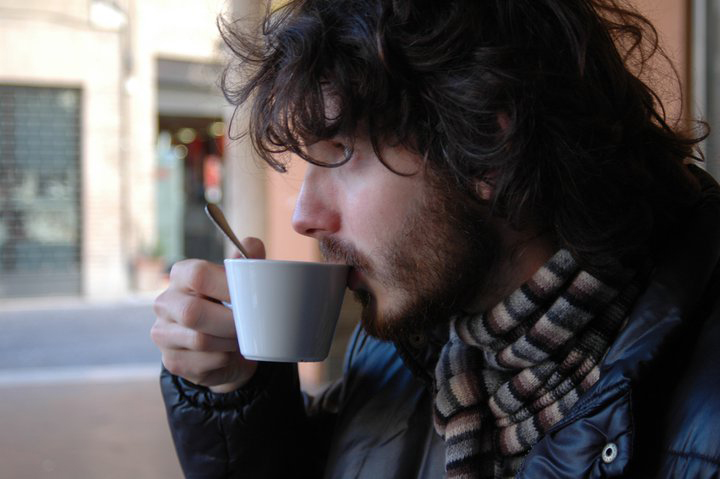
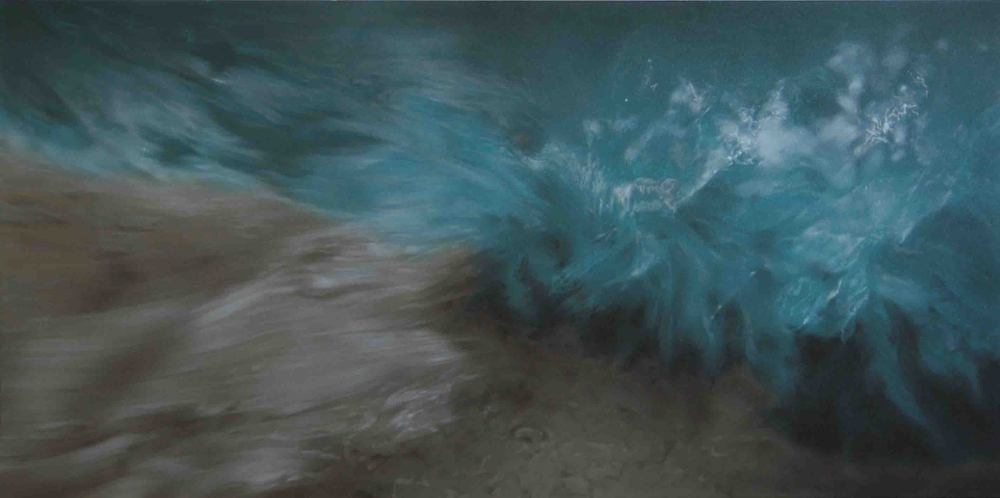
“once even the trees had eyes”…
Antonella Ventura
“Once the trees had eyes” This is the title of a poem written by Ana Blandiana, one of the most elegant Romanian poets and like the tree gives birth to talented fruits, the same way the young Romanian painter Mădălin Ciucă creates his works.
The expanded, profound, sensitive and animist humus of a land scarred by everyone and everything, still holds for all the ones who can see beyond the obvious, the reasons that gave birth to the most beautiful music of the gypsies from the Carpathians or to the aching ballades of the Jewish brothers that had kept each of their own musical instrument such as the sacred book, moving jealously from one diaspora to another one.
It is the man’s journey that led young Mădălin with his suitcase full of colors to the sacred and feminine region of Marche.
About four years ago when he came to Italy and opened this suitcase, the colors were strong and carnal, violent and astray like the ones of his Romania, then slowly they were diluted with different shades of an Italian society situated very far away from the splendor of the Renaissance.
The difference between the different languages and social customs has created within Mădălin a gradual separation but never aggressive and from the first paintings he made in Italy, the informal ones dedicated to the four elements: water, air, earth and fire, has passed with gentleness to the figurative ones, for which beyond the search for light, a natural element of stylistic language for him, he always went progressively towards the search for painting subjects that had the “light” within.
Nearly a visual narrative study.
Stories of contemporary men and women who beyond time and space, illuminate notwithstanding.
Albeit with many reservations about the idea of an exhibition where the two artistic movements coexist, it was considered interesting to gather the evolution undertaken by the young artist for whom the analysis of the social and anthropological setting of the Marche region that has welcomed him it is important.
If it is true that Italy is going through its most amorphous and obscure time, it is also important to underline that our region has within its heart all the elements necessary for a new revival of the “Italian thought”, a new Humanism from the Marche to the world.
It is a tribute to these values that give vibrancy to the content of the human-centered painting of young Mădălin, even for an informal subject, Mădălin is full of such a creative, symbolic, and visionary energy to create allegories with other worlds, other experiences or other visions, situated still there.
It is life that celebrates Mădălin’s art, which flows pulsing beyond and within the brush strokes refined mixtures, and amalgamated colors of memories and pains for the many time when life itself had been betrayed.
As the last romantic survived painter, his painting represents the visual transposition of a sonnet by Keats, painful and melancholic, embodies and translates the feeling of cosmic love, love that makes all the things alive, even the ones that ordinary mortals consider inanimate, but makes Mădălin die more when seeing an insensitive human being.
He felt a lot of pain since being a child for such a lack of respect seen from a macro cosmos towards his land, hectares and hectares of poisoned by cyanide and bloody forests for the rich pockets of the
Foreign landowners, Roșia Montana, usurpers of human rights made in the name of the wicked capitalism, abject speculations against the animals, the weakest creatures of people. All of these had touched in an irreparable way the soul of Mădălin, already hurt by other wounds.
An experience that brought him to Italy, that long dreamed Italy from Caravaggio books and so much desirable with Leonardo, it was for Mădălin the regained life.
However, from that Italy has remained only the dream from the museums, if open, even in Marche.
Mădălin has found heterogeneity of views, a generosity and richness of good things from the feelings to food which electrified him at the beginning and then let him consternated, making him unable to understand how all these would bring anguish and sadness to people instead of energy.
The informal visionary romanticism of his paintings had slowly been replaced by the white and black of the neo romantism of the first 900, mocking and ironic, like Cezanne, having in common the men and beautiful women searching for space within a crowded society.
The portrait is not a portrait, for that exists the photographer, but a kind of case history of the soul of the subject and slides and melts towards a drier and less emphasized language in order for its path to be retaken towards other shores, other faces of shores.
The result of meeting Mădălin was similar to the one with certain books that you begin to read for a certain reason and then they become the reason for a radical change of a path, having always the willing to play again, to take the suitcase full with colors only, like the one belonging to Mădălin and start the journey again.
Where? We cannot know, the only thing that matters is to know yourself and in order to do this you need to meet the Others.
The painting projected to the Other-myself has not been ever surpassed because each of us sees in others something that others cannot see, naturally without pain compared to a psychoanalytic meeting and not even the deceptive effect of an evasion because it discloses the truth when it is authentic.
The authenticity of the art is being given one more time by its universality; everyone is seeing its own story reflected by the Other. “
“Once even the trees had eyes” wants to be a small, but magical story made by encounters and friendships between me and Mădălin, between Mădălin and Elvio and between Mădălin, me, Elvio, and Alessandra-Aldo and above all between Alessandra-Aldo and the world of which they are professional visitors.
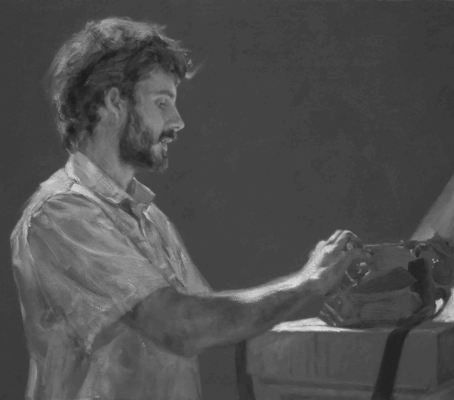
“un tempo anche gli alberi avevano gli occhi”…
Antonella Ventura
“Un tempo gli alberi avevano gli occhi” così titola la collana di poesie di Ana Blandiana, una delle più raffinate poetesse rumene ed è da quell’albero che nascono i talentuosi frutti come le opere del giovane pittore rumeno, Madalin Ciuca.
L’humus espanso, profondo, sensibile ed animista di una terra deturpata da tutti e da tutto ancora custodisce, per tutti coloro che riescono a vedere oltre l’ovvio, le ragioni che hanno dato vita alle più belle musiche degli ztigani dei Carpazi o alle ballate struggenti dei fratelli ebrei che hanno custodito ogni loro strumento musicale come il sacro libro, gelosamente, spostandosi di diaspora in diaspora.
E’ il cammino dell’uomo che ha condotto nelle Marche, terra sacra e femminile, il giovane Madalin con una “valigia” carica di colori.
Quando ha aperto questa valigia, circa quattro anni fa al suo arrivo in Italia, i colori erano forti e “carnali”, violenti e traviati come quelli della sua Romania, poi lentamente, si sono stemperati con le sfumature tono su tono di una società italiana lontana anni luce dai fasti del Rinascimento.
La differenza dei vari linguaggi e costumi sociali ha prodotto in Madalin una separazione graduale e mai aggressiva, e dai primi lavori realizzati in Italia, quelli informali, dedicati ai quattro elementi: acqua, aria, terra e fuoco è passato con dolcezza ai figurativi, dove, più che della ricerca della luce per lui elemento naturale di linguaggio stilistico proprio, è andato di volta in volta sempre più verso la ricerca di soggetti da ritrarre che abbiano in sé una “luce”.
Quasi uno studio narrativo visivo.
Storie di uomini e di donne contemporanei che aldilà del tempo e di uno spazio, illuminano, nonostante.
Seppur con molte riserve all’idea di una esposizione dove i due momenti artistici convivono, si è considerato interessante cogliere l’evoluzione intrapresa dal giovane artista, dove, non secondaria, è l’analisi dell’ambientazione sociale e antropologica della terra che lo ha accolto, le Marche.
Perché se è vero che l’Italia sta vivendo il suo periodo più amorfo e inglorioso, è altresì importante sottolineare che la nostra regione ha in cuor suo tutti gli elementi per una nuova rinascita del “pensiero italico”, un nuovo Umanesimo dalle Marche per il mondo.
E ‘ un omaggio a questi valori quello che muove i contenuti della pittura del giovane Madalin, umano-centrica, pur anche un soggetto informale, in Madalin è carico di una tale energia creativa, simbolica e visionaria tanto da creare allegorie con altri mondi, con altri vissuti, ed altri spazi, altre angolazioni di luci cosmiche o stati di coscienza, spazi interiori o altre visioni, ancora, fuori!
E’ la vita a celebrare l’arte di Madalin, scorre pulsante dietro e dentro pennellate, impasti raffinati di colori amalgamati a ricordi e dolori per le tante volte che la stessa è stata tradita.
Ultimo pittore romantico sopravvissuto, la sua pittura è la trasposizione visiva di un sonetto di Keats, struggente e malinconico, incarna e traduce i sentimenti dell’amore cosmico, un Amore che fa vivere tutte le cose, anche quelle che i comuni mortali dicono essere inanimate, ma fa morire sempre più Madalin dell’umano vivere insensibile.
Quanto dolore ha provato sin da piccolo per tanta mancanza di rispetto, vista da un macro-cosmo intorno alla sua terra, ettari ed ettari di bosco dissanguato e avvelenato di cianuro, per le ricche tasche dei latifondisti stranieri, Rosai Montana, usurpazioni di diritti umani perpetrati in nome del capitalismo più scellerato, abbiette speculazioni contro le creature più deboli dell’uomo, gli animali. Tutto questo, ha segnato irrimediabilmente l’animo di Madalin, già reduce chissà da quali ferite. Un vissuto che lo ha portato in Italia, quell’Italia tanto sognata sui libri con Caravaggio, e tanto ambita con Leonardo, è stata per Madalin la vita ritrovata..
Di quell’Italia però, non’è rimasta che il sogno nei musei, se stanno aperti, eppure nelle Marche. Madalin ha trovato una eterogeneità di panorami, una generosità e una ricchezza di tante buone cose dai sentimenti alle cose da mangiare che, lo hanno dapprima elettrizzato e poi lasciato sgomento, non poteva capire infatti come, tutto questo, non portasse alla gente energia, spensieratezza, invece che angosce e tristezza.
Il romanticismo visionario informale dei suoi quadri piano, piano cede il passo a un bianco e nero del neo-romanticismo dei primi del 900, beffardo ed ironico, come quello Cezanne, ed ha il tratto degli uomini e delle donne che, belle cercano uno spazio in una società siffatta angusta.
Il ritratto non’è il ritratto per quello c’è il fotografo, ma una sorta di anamnesi dell’animo del soggetto in questione e scivola o scivolerà verso un linguaggio più asciutto e meno enfatizzato, sempre che il suo cammino riparta, per altri lidi, per altri visi su altre sponde.
Il risultato dell’incontro con Madalin è un pò come quello che avviene con certi libri quelli che poi inizi per un motivo, poi invece diventano il motivo del cambiamento radicale di un percorso, sempre che si abbia voglia di mettersi di nuovo in gioco, di prendere di nuovo una valigia seppur di soli colori come quella di Madalin e riprendere il cammino.
Verso dove? Questo non’è dato sapere, la sola cosa che conta e di conoscersi e per farlo, bisogna incontrare gli Altri.
La pittura proiettata sull’Altro-me stesso, non’è mai superata, perché ognuno vede ciò che ad altri sfugge, naturalmente, senza dolore rispetto ad una seduta psicanalitica, e nemmeno sortisce l’effetto ingannevole di un’evasione, perché ne svela la verità, quando è autentica.
L’autenticità dell’arte è data di nuovo dalla sua universalità, tutti vedono, la loro storia, nell’Altro.
“Un tempo anche gli alberi avevano gli occhi” vuole essere una piccola ma magica storia, fatta di incontri e di amicizie tra me e Madalin, tra Madalin ed Elvio, e tra Madalin, io, Elvio e Alessandra-Aldo e soprattutto tra Alessandra-Aldo e il mondo di cui loro sono esperti visitatori.
.-.-..-.
Comunicato stampa
Sabato 18 Febbraio 2012, alle ore 18.00, nello spazio espositivo Marche & Tour Expo, Terminal Arrivi, dell’Aeroporto di Falconara, sarà inaugurata la mostra di pittura: “un tempo anche gli alberi avevano gli occhi”.
L’esposizione del giovane e talentuoso artista Madalin Ciuca, è curata da Antonella Ventura, ed è promossa dalla Fondazione Zamperetti Onlus, una delle istituzioni culturali più prestigiose del panorama nazionale ed internazionale che, attraverso uno spazio dinamico ed interattivo, collegato al percorso museale della regione, “Marche & Tour Expo”, presenta le più interessanti idee artistiche del territorio.
La mostra gode del Patrocinio della Regione Marche e dell’Assessorato alla cultura di tutte le Provincie delle Marche, patrocini estesi a tutte le iniziative presentate dalla Fondazione Zamperetti, per l’alto standing e la professionalità nel presentare la Cultura delle Marche nel mondo.
L’iniziativa, “un tempo anche gli alberi avevano gli occhi”, esposizione di opere pittoriche di Madalin Ciuca, rappresenta inoltre un momento particolare, per conoscere ed affermare un giovane talento europeo, che ha scelto di vivere e lavorare nelle Marche, ribadendo la mission più nobile della stessa Fondazione, l’aiuto ai giovani meritevoli.
La mostra si compone di 9 opere esposte, olio su tela, 4 del periodo informale dedicate ai 4 elementi naturali (acqua, aria, terra e fuoco), e 5 opere figurative, tra cui spicca il suo autoritratto, opera esposta nell’ultima Biennale di Venezia.
La scelta del titolo (una poesia di Ana Blandiana) vuole essere un omaggio alla Terra di Romania, paese natio di Madalin Ciuca, un paese vituperato e umiliato che però cela un’antica e fastosa bellezza.
Come la poesia di Ana Blandiana canta e le opere di Madalin Ciuca raffigurano.
Opening: Sabato 18 Febbraio 2012 ore 18.00
SALA ARRIVI – AEREOPORTO RAFFAELLO SANZIO DI FALCONARA
18 Febbraio 2012 – 02 Marzo 2012
ingresso libero h 9-13 e 16-20
GIULIANA de ANTONELLIS – Ufficio stampa dell’ Associazione culturale “Arte per le Marche” – Milano
email giulianadeantonellis@hotmail.com – www.gdapress.it – Tel. + 0039 339 827 9 339
Concept artistico: Elvio Ciccardini email: ciccardinielvio@gmail.com Tel. +0039 327 3763517


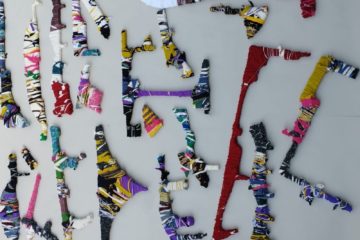
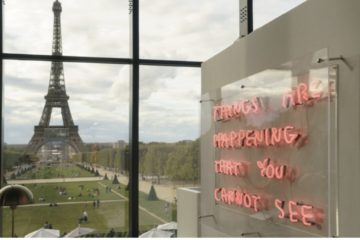
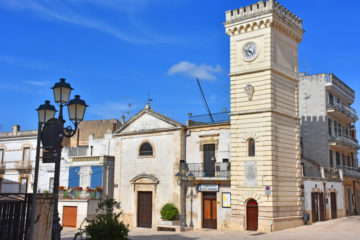
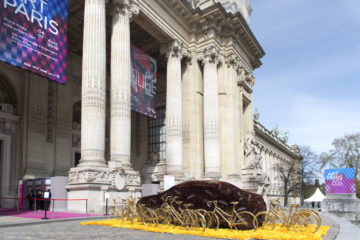

No Comment